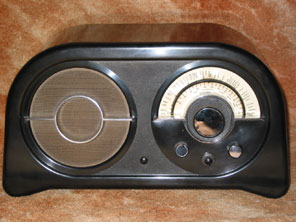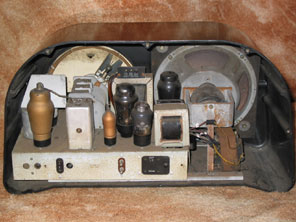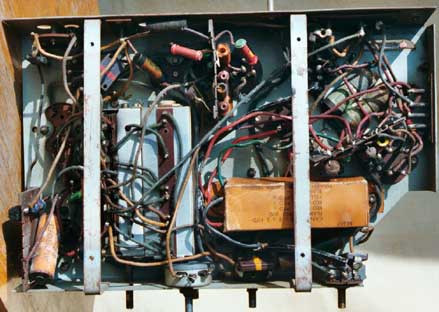|












| |
Ekco Radio Continued,
Model AC86
 
The next classic Ekco to be considered is the AC86 from
1935. The chassis and circuit in
the AC86 is not dissimilar to that of
the AC85 from a year earlier. Still
incorporated is the previously discussed “Noise Suppressor” control and AVC.
A continuously variable tone control has also moved to the front of the
receiver. The valve line-up is FC4,
AC/VP1, 2D4A, 354V, AC/PEN, IW3, the same as the AC85 except that the double
diode V914 in the AC85 becomes 2D4A in the AC86, (they are generally
interchangeable anyway). At £13.2.0 for brown and £13.13.0 the prices were
almost the same as for the AC85.
The AC86 is housed in a cabinet designed by Serge Chemayeff.
Chemayeff was a Russian émigré, already known in Britain for his design
(together with Erich Mendelsohn) of the modernist Bexhill-On-Sea Lido.
In fact this cabinet is not wildly different from the early AC85, but it
may have been that he had to work around the existing chassis and control
layout, thereby providing restrictions to his design brief.
The set however looks very good, particularly in the black and chrome
version shown.
 Shown
left is the chassis underside. This
receiver is fully working, and like the AC85 I have re-built modern components
into their original housings. Fortunately
when I obtained this receiver not even the wax paper block smoothing
electrolytics had been replaced, so I was able to dig out the insides and re-use
the cardboard outer to encase modern new components, thereafter re-sealing with
wax. Eight other capacitors were
also re-built. Having
restored the AC86 shown so that it looked totally original both topside and
under chassis it sounded terrific, and it was whilst demonstrating it to a
friend that disaster occurred. After switch on it sounded great for about a minute, then the
sound died. Later checks revealed
the HT had gone, and this was subsequently found to be because the output
transformer had gone open circuit. I’ve
got the receiver working again with another transformer (seen under the speaker
top right photo), and to the left the failed component still in place on the chassis.
The original transformer is particularly “meaty”, and therefore
probably contributes to the excellent sound quality of the receiver.
For that reason, and because the rest of the receiver is original, I will
probably either have the transformer re-wound or attempt it myself, when time
permits! Shown
left is the chassis underside. This
receiver is fully working, and like the AC85 I have re-built modern components
into their original housings. Fortunately
when I obtained this receiver not even the wax paper block smoothing
electrolytics had been replaced, so I was able to dig out the insides and re-use
the cardboard outer to encase modern new components, thereafter re-sealing with
wax. Eight other capacitors were
also re-built. Having
restored the AC86 shown so that it looked totally original both topside and
under chassis it sounded terrific, and it was whilst demonstrating it to a
friend that disaster occurred. After switch on it sounded great for about a minute, then the
sound died. Later checks revealed
the HT had gone, and this was subsequently found to be because the output
transformer had gone open circuit. I’ve
got the receiver working again with another transformer (seen under the speaker
top right photo), and to the left the failed component still in place on the chassis.
The original transformer is particularly “meaty”, and therefore
probably contributes to the excellent sound quality of the receiver.
For that reason, and because the rest of the receiver is original, I will
probably either have the transformer re-wound or attempt it myself, when time
permits!
Continue to the Ekco
ACT96
© COPYRIGHT RETAINED ON ALL TEXT AND PICTURES ON THIS SITE.
|







